- keras
这个图描述神经网络挺形象的

keras
搭建一个神经网络
增加各个层
compiling:compile
train:fit
predict:predict
evaluate loss:evaluate
sequence这里比较方便一点
以输入为2,输出层只有1为例

# Import the Sequential model and Dense layer
from keras.models import Sequential
from keras.layers import Dense
# Create a Sequential model
model = Sequential()
# Add an input layer and a hidden layer with 10 neurons
model.add(Dense(10, input_shape=(2,), activation="relu"))
# Add a 1-neuron output layer
model.add(Dense(1))
# Summarise your model
model.summary()
一个比较完整的栗子
# Instantiate a Sequential model
model = Sequential()
# Add a Dense layer with 50 neurons and an input of 1 neuron
model.add(Dense(50, input_shape=(1,), activation='relu'))
# Add two Dense layers with 50 neurons and relu activation
model.add(Dense(50, activation='relu'))
model.add(Dense(50, activation='relu'))
# End your model with a Dense layer and no activation
model.add(Dense(1))
# Compile your model
model.compile(optimizer = 'adam', loss = 'mse')
print("Training started..., this can take a while:")
# Fit your model on your data for 30 epochs
model.fit(time_steps, y_positions, epochs = 30)
# Evaluate your model
print("Final lost value:",model.evaluate(time_steps, y_positions))
# Predict the twenty minutes orbit
twenty_min_orbit = model.predict(np.arange(-10, 11))
# Plot the twenty minute orbit
plot_orbit(twenty_min_orbit)
binary classification
那输出的dense层的激活函数是sigmoid就可以了
# Import the sequential model and dense layer
from keras.models import Sequential
from keras.layers import Dense
# Create a sequential model
model = Sequential()
# Add a dense layer
model.add(Dense(1, input_shape=(4,), activation='sigmoid'))
# Compile your model
model.compile(loss='binary_crossentropy', optimizer='sgd', metrics=['accuracy'])
# Display a summary of your model
model.summary()
# Train your model for 20 epochs,假设这里划分好了数据集
model.fit(X_train, y_train, epochs=20)
# Evaluate your model accuracy on the test set
accuracy = model.evaluate(X_test, y_test)[1]
# Print accuracy
print('Accuracy:',accuracy)
Multi-class classification
多分类的话,就是输出的激活函数不是sigmoid了,而是softmax了
所以写一个多分类的流程
就是
定义输入层和隐藏层
定义更多的隐藏层
定义输出层,输出层的结点数量大于一
demo
定义一个含有三个隐藏层神经网络,输出为4分类
# Instantiate a sequential model
model = Sequential()
# Add 3 dense layers of 128, 64 and 32 neurons each
model.add(Dense(128, input_shape=(2,), activation='relu'))
model.add(Dense(64, activation='relu'))
model.add(Dense(32, activation='relu'))
# Add a dense layer with as many neurons as competitors
model.add(Dense(4, activation='softmax'))
# Compile your model using categorical_crossentropy loss
model.compile(loss='categorical_crossentropy',
optimizer='adam',
metrics=['accuracy'])
# Train your model on the training data for 200 epochs
model.fit(coord_train, competitors_train, epochs=200)
# Evaluate your model accuracy on the test data
accuracy = model.evaluate(coord_test, competitors_test)[1]
# Print accuracy
print('Accuracy:', accuracy)
编码形式
labelcoder
# Transform into a categorical variable
darts.competitor = pd.Categorical(darts.competitor)
# Assign a number to each category (label encoding)
darts.competitor = darts.competitor.cat.codes
# Print the label encoded competitors
print('Label encoded competitors:
',darts.competitor.head())
<script.py> output:
Label encoded competitors:
0 2
1 3
2 1
3 0
4 2
Name: competitor, dtype: int8
one hot
# Transform into a categorical variable
darts.competitor = pd.Categorical(darts.competitor)
# Assign a number to each category (label encoding)
darts.competitor = darts.competitor.cat.codes
# Import to_categorical from keras utils module
from keras.utils import to_categorical
# Use to_categorical on your labels
coordinates = darts.drop(['competitor'], axis=1)
competitors = to_categorical(darts.competitor)
# Now print the to_categorical() result
print('One-hot encoded competitors:
',competitors)
Multi-label classification
dense的结点不是1了,而是大于1的,激活函数还是sigmoid
# Instantiate a Sequential model
model = Sequential()
# Add a hidden layer of 64 neurons and a 20 neuron's input
model.add(Dense(64, input_shape=(20,), activation='relu'))
# Add an output layer of 3 neurons with sigmoid activation
model.add(Dense(3, activation='sigmoid'))
# Compile your model with adam and binary crossentropy loss
model.compile(optimizer='adam',
loss='binary_crossentropy',
metrics=['accuracy'])
model.summary()
# Train for 100 epochs using a validation split of 0.2
model.fit(sensors_train, parcels_train, epochs=100, validation_split=0.2)
# Predict on sensors_test and round up the predictions
preds = model.predict(sensors_test)
preds_rounded = np.round(preds)
# Print rounded preds
print('Rounded Predictions:
', preds_rounded)
# Evaluate your model's accuracy on the test data
accuracy = model.evaluate(sensors_test, parcels_test)[1]
# Print accuracy
print('Accuracy:', accuracy)
Keras callbacks
回调函数使用
回调函数是一个函数的合集,会在训练的阶段中所使用。你可以使用回调函数来查看训练模型的内在状态和统计。你可以传递一个列表的回调函数(作为 callbacks 关键字参数)到 Sequential 或 Model 类型的 .fit() 方法。在训练时,相应的回调函数的方法就会被在各自的阶段被调用。keras.cn
在每个training/epoch/batch结束时,如果我们想执行某些任务,例如模型缓存、输出日志、计算当前的auc等等,Keras中的callback就派上用场了。
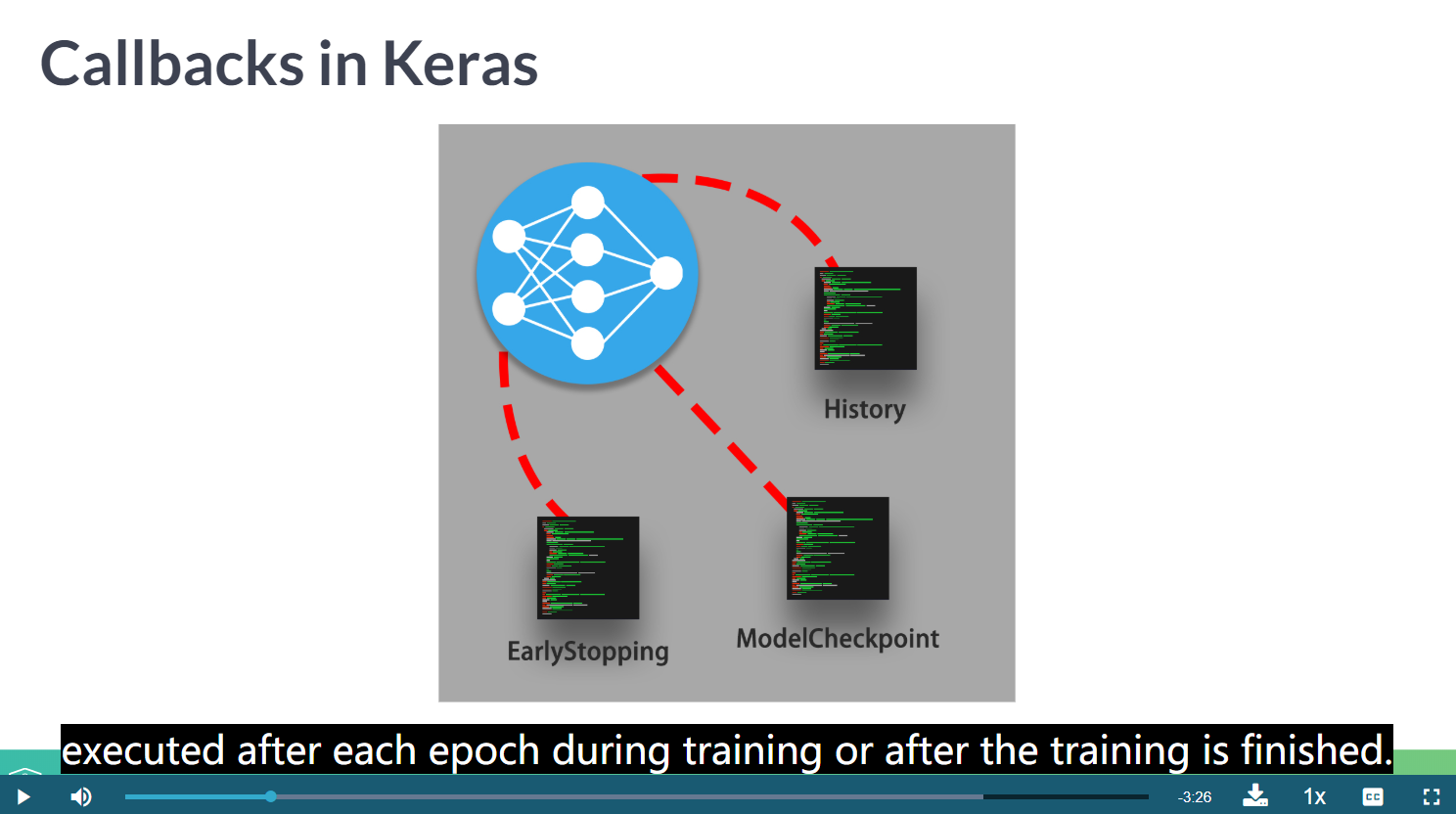
callbacks可以用来做这些事情:
模型断点续训:保存当前模型的所有权重
提早结束:当模型的损失不再下降的时候就终止训练,当然,会保存最优的模型。
动态调整训练时的参数,比如优化的学习速度。
等等
earlystopping和modelcheckpoint抄书侠
import keras
# Callbacks are passed to the model fit the `callbacks` argument in `fit`,
# which takes a list of callbacks. You can pass any number of callbacks.
callbacks_list = [
# This callback will interrupt training when we have stopped improving
keras.callbacks.EarlyStopping(
# This callback will monitor the validation accuracy of the model
monitor='acc',
# Training will be interrupted when the accuracy
# has stopped improving for *more* than 1 epochs (i.e. 2 epochs)
patience=1,
),
# This callback will save the current weights after every epoch
keras.callbacks.ModelCheckpoint(
filepath='my_model.h5', # Path to the destination model file
# The two arguments below mean that we will not overwrite the
# model file unless `val_loss` has improved, which
# allows us to keep the best model every seen during training.
monitor='val_loss',
save_best_only=True,
)
]
# Since we monitor `acc`, it should be part of the metrics of the model.
model.compile(optimizer='rmsprop', loss='binary_crossentropy', metrics=['acc'])
# Note that since the callback will be monitor validation accuracy,
# we need to pass some `validation_data` to our call to `fit`.
model.fit(x, y,
epochs=10,
batch_size=32,
callbacks=callbacks_list,
validation_data=(x_val, y_val))
monitor为选择的检测指标,我们这里选择检测'acc'识别率为指标,patience就是我们能让训练停止变好多少epochs才终止训练,这里选择了1,而modelcheckpoint就起到了存储最优的模型的作用,filepath为我们存储的位置和模型名称,以.h5为后缀,monitor为检测的指标,这里我们检测验证集里面的成功率,save_best_only代表我们只保存最优的训练结果。
而validation_data就是给定的验证集数据。
学习率减少callback抄书侠
callbacks_list = [
keras.callbacks.ReduceLROnPlateau(
# This callback will monitor the validation loss of the model
monitor='val_loss',
# It will divide the learning by 10 when it gets triggered
factor=0.1,
# It will get triggered after the validation loss has stopped improving
# for at least 10 epochs
patience=10,
)
]# Note that since the callback will be monitor validation loss,
# we need to pass some `validation_data` to our call to `fit`.
model.fit(x, y,
epochs=10,
batch_size=32,
callbacks=callbacks_list,
validation_data=(x_val, y_val))
翻译一下,就是如果连续10个批次,val_loss不再下降,就把学习率弄到原来的0.1倍。
history callback
# Train your model and save its history
history = model.fit(X_train, y_train, epochs = 50,
validation_data=(X_test, y_test))
# Plot train vs test loss during training
plot_loss(history.history['loss'], history.history['val_loss'])
# Plot train vs test accuracy during training
plot_accuracy(history.history['acc'], history.history['val_acc'])
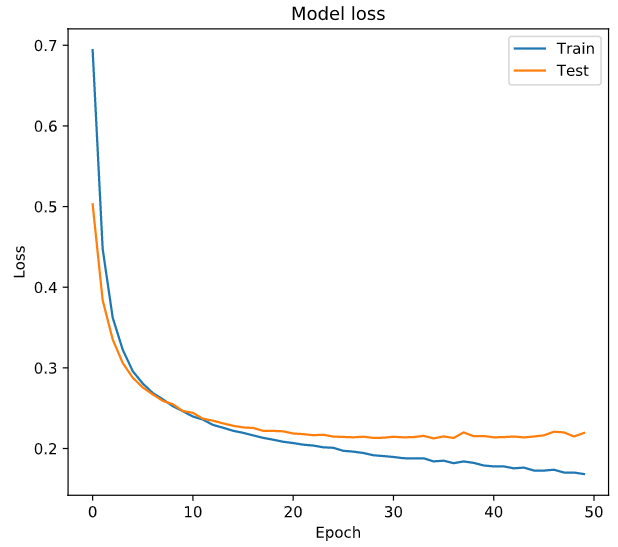
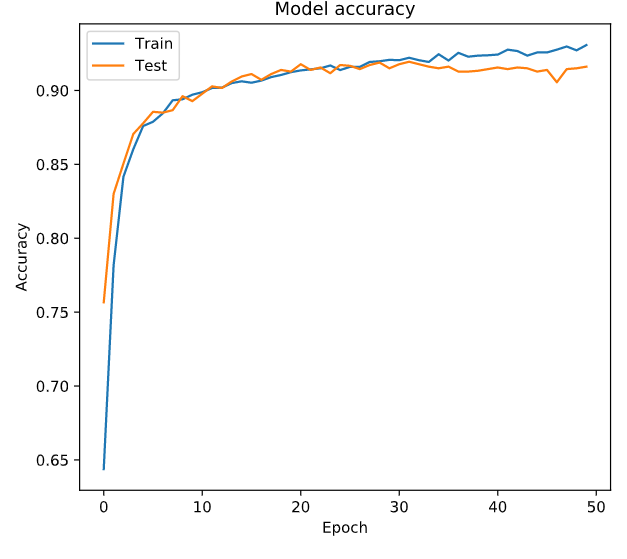
Early stopping your model
The early stopping callback is useful since it allows for you to stop the model training if it no longer improves after a given number of epochs. To make use of this functionality you need to pass the callback inside a list to the model's callback parameter in the .fit() method.
# Import the early stopping callback
from keras.callbacks import EarlyStopping
# Define a callback to monitor val_acc
monitor_val_acc = EarlyStopping(monitor='val_acc',
patience=5)
# Train your model using the early stopping callback
model.fit(X_train, y_train,
epochs=1000, validation_data=(X_test, y_test),
callbacks=[monitor_val_acc])
EarlyStopping and ModelCheckpoint callbacks
当验证集的误差不再发生变化的时候,停止迭代,并且保存模型为hdf5格式
# Import the EarlyStopping and ModelCheckpoint callbacks
from keras.callbacks import EarlyStopping, ModelCheckpoint
# Early stop on validation accuracy
monitor_val_acc = EarlyStopping(monitor = 'val_acc', patience = 3)
# Save the best model as best_banknote_model.hdf5
modelCheckpoint = ModelCheckpoint('best_banknote_model.hdf5', save_best_only = True)
# Fit your model for a stupid amount of epochs
history = model.fit(X_train, y_train,
epochs = 10000000,
callbacks = [monitor_val_acc, modelCheckpoint],
validation_data = (X_test, y_test))
模型的保存方式
h5格式
Learning curves
学习曲线
查看损失函数的curve和accuary的curve
# Instantiate a Sequential model
model = Sequential()
# Input and hidden layer with input_shape, 16 neurons, and relu
model.add(Dense(16, input_shape = (64,), activation = 'relu'))
# Output layer with 10 neurons (one per digit) and softmax
model.add(Dense(10, activation = 'softmax'))
# Compile your model
model.compile(optimizer = 'adam', loss = 'categorical_crossentropy', metrics = ['accuracy'])
# Test if your model works and can process input data
print(model.predict(X_train))
# 这里划分数据集的方式是通用的,不过这个是留出法
# Train your model for 60 epochs, using X_test and y_test as validation data
history = model.fit(X_train, y_train, epochs=60, validation_data=(X_test, y_test), verbose=0)
# Extract from the history object loss and val_loss to plot the learning curve
plot_loss(history.history['loss'], history.history['val_loss'])
for size in training_sizes:
# Get a fraction of training data (we only care about the training data)
X_train_frac, y_train_frac = X_train[:size], y_train[:size]
# Reset the model to the initial weights and train it on the new data fraction
model.set_weights(initial_weights)
model.fit(X_train_frac, y_train_frac, epochs = 50, callbacks = [early_stop])
# Evaluate and store the train fraction and the complete test set results
train_accs.append(model.evaluate(X_train_frac, y_train_frac)[1])
test_accs.append(model.evaluate(X_test, y_test)[1])
# Plot train vs test accuracies
plot_results(train_accs, test_accs)
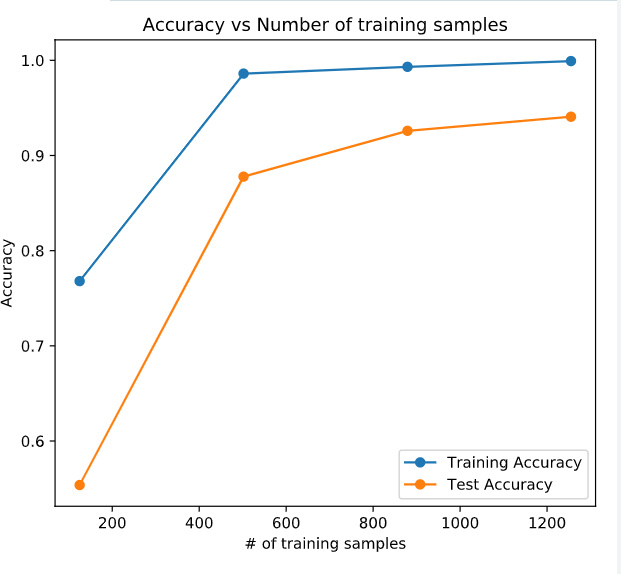
激活函数
神经网络的内部就是一堆的数相乘,求和的过程,这个图很形象了
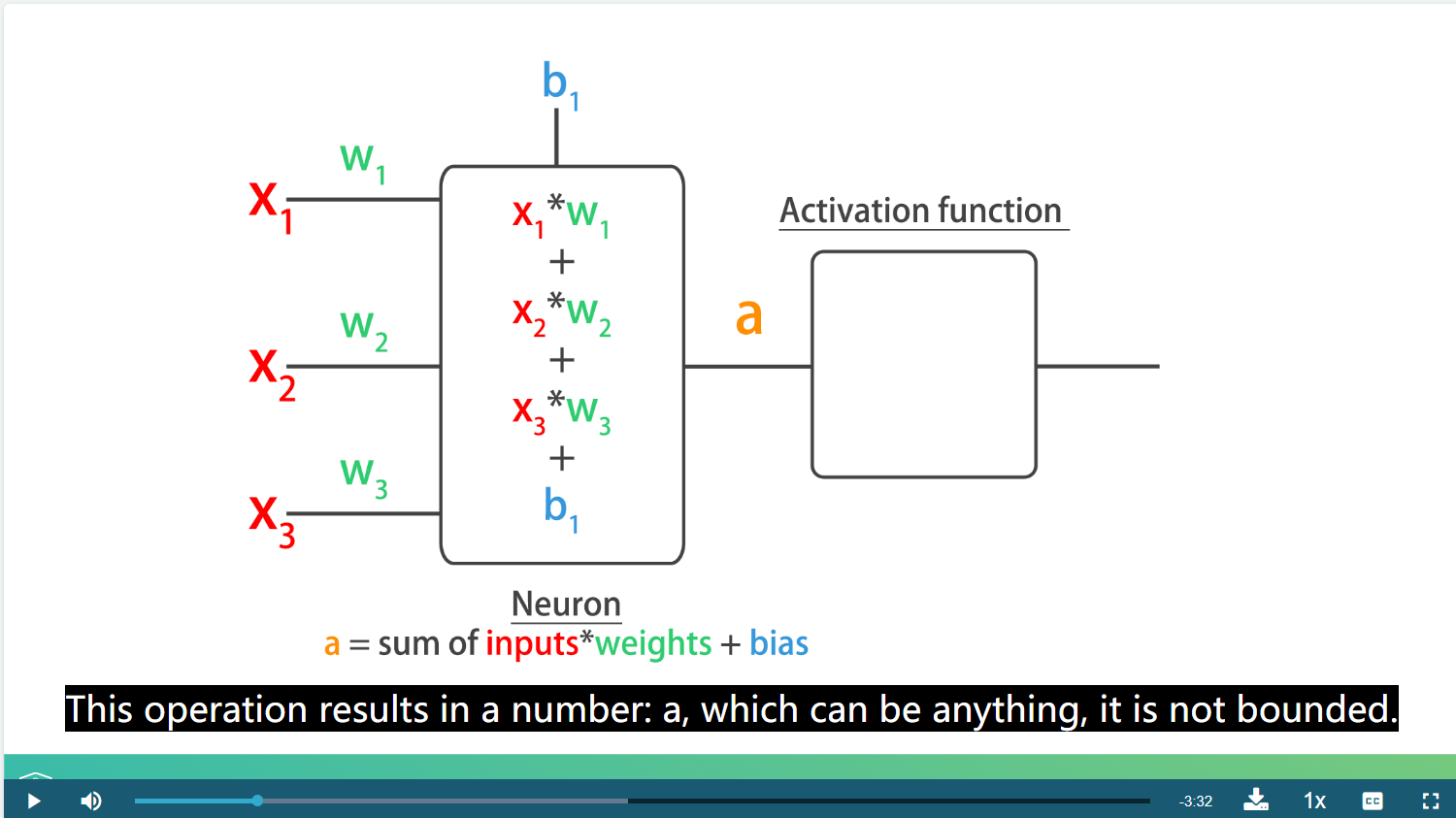
Batch size and batch normalization
分批的尺寸和每批的正则化
批量标准化层 (Ioffe and Szegedy, 2014)。
在每一个批次的数据中标准化前一层的激活项, 即,应用一个维持激活项平均值接近 0,标准差接近 1 的转换。
# Import batch normalization from keras layers
from keras.layers import BatchNormalization
# Build your deep network
batchnorm_model = Sequential()
batchnorm_model.add(Dense(50, input_shape=(64,), activation='relu', kernel_initializer='normal'))
batchnorm_model.add(BatchNormalization())
batchnorm_model.add(Dense(50, activation='relu', kernel_initializer='normal'))
batchnorm_model.add(BatchNormalization())
batchnorm_model.add(Dense(50, activation='relu', kernel_initializer='normal'))
batchnorm_model.add(BatchNormalization())
batchnorm_model.add(Dense(10, activation='softmax', kernel_initializer='normal'))
# Compile your model with sgd
batchnorm_model.compile(optimizer='sgd', loss='categorical_crossentropy', metrics=['accuracy'])
# Train your standard model, storing its history
history1 = standard_model.fit(X_train, y_train, validation_data=(X_test, y_test), epochs=10, verbose=0)
# Train the batch normalized model you recently built, store its history
history2 = batchnorm_model.fit(X_train, y_train, validation_data=(X_test, y_test), epochs=10, verbose=0)
# Call compare_acc_histories passing in both model histories
compare_histories_acc(history1, history2)

Hyperparameter tuning
超参数调节
# Import KerasClassifier from keras wrappers
from keras.wrappers.scikit_learn import KerasClassifier
# Create a KerasClassifier
model = KerasClassifier(build_fn = create_model, epochs = 50,
batch_size = 128, verbose = 0)
# Calculate the accuracy score for each fold
kfolds = cross_val_score(model, X, y, cv = 3)
# Print the mean accuracy
print('The mean accuracy was:', kfolds.mean())
# Print the accuracy standard deviation
print('With a standard deviation of:', kfolds.std())
目前来看是一样的
keras backend
这里等熟悉keras包之后回看
Keras是一个模型级的库,提供了快速构建深度学习网络的模块。Keras并不处理如张量乘法、卷积等底层操作。这些操作依赖于某种特定的、优化良好的张量操作库。Keras依赖于处理张量的库就称为“后端引擎”。Keras提供了三种后端引擎Theano/Tensorflow/CNTK,并将其函数统一封装,使得用户可以以同一个接口调用不同后端引擎的函数
Theano是一个开源的符号主义张量操作框架,由蒙特利尔大学LISA/MILA实验室开发。
TensorFlow是一个符号主义的张量操作框架,由Google开发。
CNTK是一个由微软开发的商业级工具包。keras中文文档
from keras import backend as K
导入后K模块提供的所有方法都是abstract keras backend API。
autoencoders
Autoencoders have several interesting applications like anomaly detection or image denoising. They aim at producing an output identical to its inputs. The input will be compressed into a lower dimensional space, encoded. The model then learns to decode it back to its original form.
自编码器
自编码器的输入和输出是一样的,降维再dense层
# Start with a sequential model
autoencoder = Sequential()
# Add a dense layer with the original image as input
autoencoder.add(Dense(32, input_shape=(784, ), activation="relu"))
# Add an output layer with as many nodes as the image
autoencoder.add(Dense(784, activation="sigmoid"))
# Compile your model
autoencoder.compile(optimizer='adadelta', loss='binary_crossentropy')
# Take a look at your model structure
autoencoder.summary()
<script.py> output:
Model: "sequential_1"
_________________________________________________________________
Layer (type) Output Shape Param #
=================================================================
dense_1 (Dense) (None, 32) 25120
_________________________________________________________________
dense_2 (Dense) (None, 4) 132
=================================================================
Total params: 25,252
Trainable params: 25,252
Non-trainable params: 0
_________________________________________________________________
<script.py> output:
Model: "sequential_1"
_________________________________________________________________
Layer (type) Output Shape Param #
=================================================================
dense_1 (Dense) (None, 32) 25120
_________________________________________________________________
dense_2 (Dense) (None, 784) 25872
=================================================================
Total params: 50,992
Trainable params: 50,992
Non-trainable params: 0
_________________________________________________________________
增加一层encoder编码
# Build your encoder
encoder = Sequential()
encoder.add(autoencoder.layers[0])
# Encode the images and show the encodings
preds = encoder.predict(X_test_noise)
show_encodings(preds)
# Predict on the noisy images with your autoencoder
decoded_imgs = autoencoder.predict(X_test_noise)
# Plot noisy vs decoded images
compare_plot(X_test_noise, decoded_imgs)

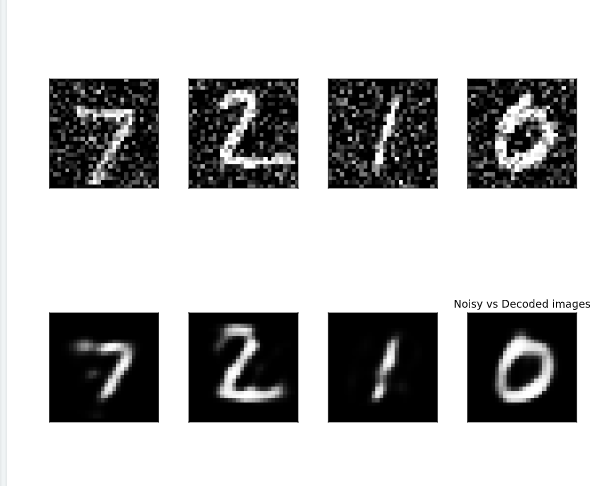
CNN
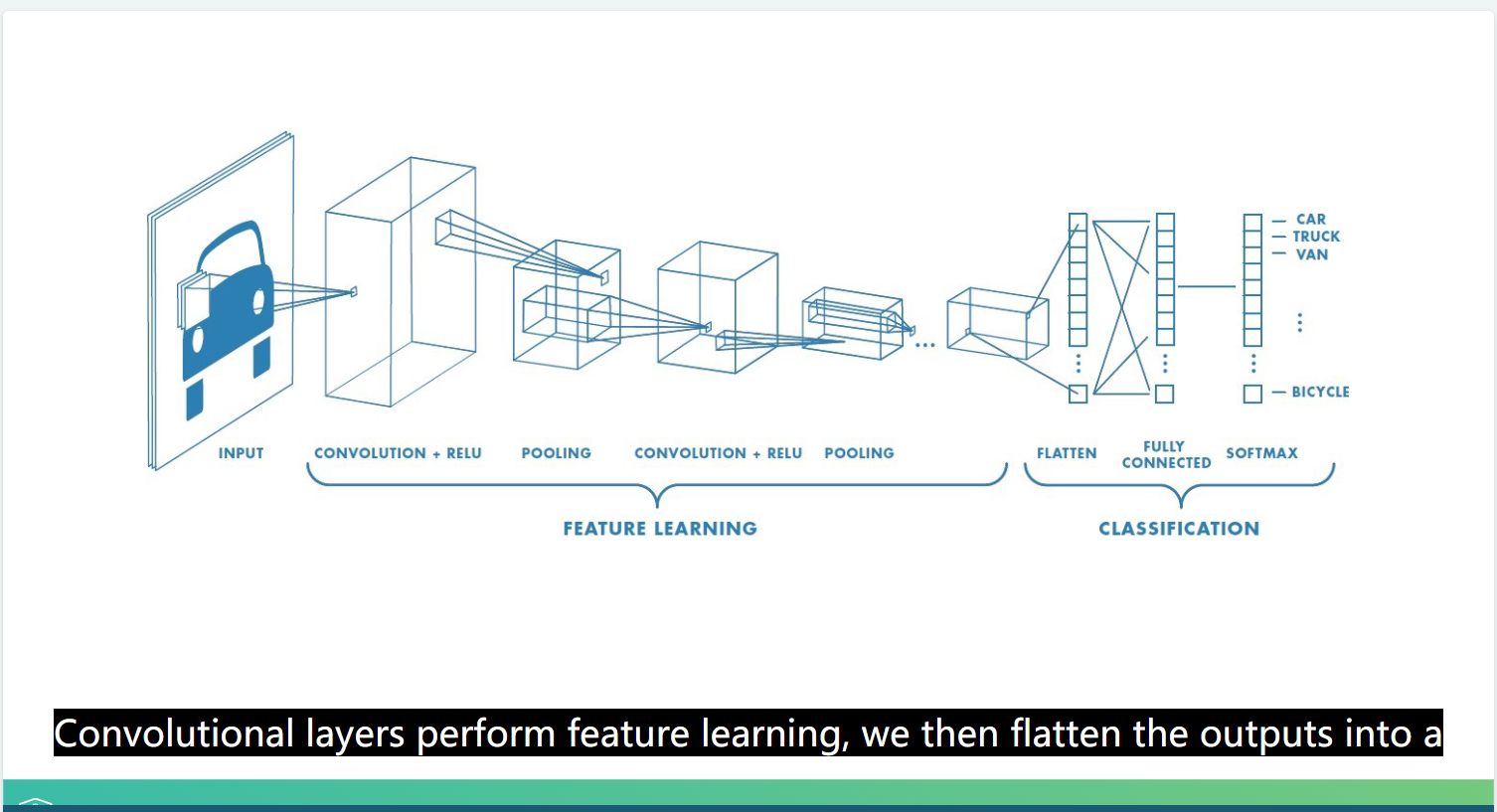
卷积神经网络
图是三维张量
# Import the Conv2D and Flatten layers and instantiate model
from keras.layers import Conv2D,Flatten
model = Sequential()
# Add a convolutional layer of 32 filters of size 3x3
model.add(Conv2D(32, input_shape=(28, 28, 1), kernel_size=3, activation='relu'))
# Add a convolutional layer of 16 filters of size 3x3
model.add(Conv2D(16, kernel_size=3, activation='relu'))
# Flatten the previous layer output
model.add(Flatten())
# Add as many outputs as classes with softmax activation
model.add(Dense(10, activation='softmax'))
# Obtain a reference to the outputs of the first layer
layer_output = model.layers[0].output
# Build a model using the model input and the first layer output
first_layer_model = Model(inputs = model.input, outputs = layer_output)
# Use this model to predict on X_test
activations = first_layer_model.predict(X_test)
# Plot the first digit of X_test for the 15th filter
axs[0].matshow(activations[0,:,:,14], cmap = 'viridis')
# Do the same but for the 18th filter now
axs[1].matshow(activations[0,:,:,17], cmap = 'viridis')
plt.show()
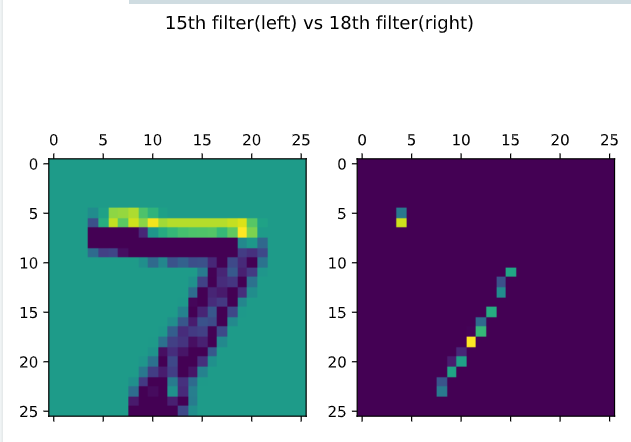
ResNet50
预训练模型
LSTM
# Split text into an array of words
words = text.split()
# Make lines of 4 words each, moving one word at a time
lines = []
for i in range(4, len(words)):
lines.append(' '.join(words[i-4:i]))
# Instantiate a Tokenizer, then fit it on the lines
tokenizer = Tokenizer()
tokenizer.fit_on_texts(lines)
# Turn lines into a sequence of numbers
sequences = tokenizer.texts_to_sequences(lines)
print("Lines:
{}
Sequences:
{}".format(lines[:5],sequences[:5]))
搭建一个lstm
# Import the Embedding, LSTM and Dense layer
from keras.layers import Embedding, LSTM, Dense
model = Sequential()
# Add an Embedding layer with the right parameters
model.add(Embedding(input_dim=vocab_size, output_dim=8, input_length=3))
# Add a 32 unit LSTM layer
model.add(LSTM(32))
# Add a hidden Dense layer of 32 units and an output layer of vocab_size with softmax
model.add(Dense(32, activation='relu'))
model.add(Dense(vocab_size, activation='softmax'))
model.summary()
<script.py> output:
Model: "sequential_1"
_________________________________________________________________
Layer (type) Output Shape Param #
=================================================================
embedding_1 (Embedding) (None, 3, 8) 352
_________________________________________________________________
lstm_1 (LSTM) (None, 32) 5248
_________________________________________________________________
dense_1 (Dense) (None, 32) 1056
_________________________________________________________________
dense_2 (Dense) (None, 44) 1452
=================================================================
Total params: 8,108
Trainable params: 8,108
Non-trainable params: 0
_________________________________________________________________
